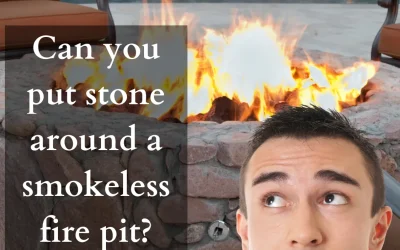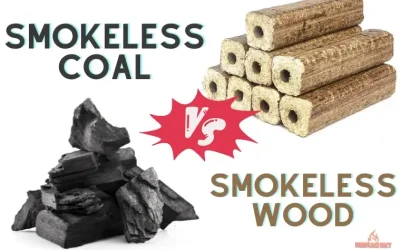No outdoor adventure is genuinely complete unless there is a fire. Maybe you’ve already bought a smokeless fire pit or still thinking about buying one. But, you might be missing out on one of the best features of your fire pit if you’re not burning the right fuel.
In general there are around 7 different fuel types that you can burn in a fire pit that is smokeless. But, they are all not created the same and you need to know the best one for you depending on your specific needs, so you can gather around the fire without having to smell it. Read this smokeless fire pit fuel guide to learn more about suitable materials to burn because they sure aren’t created equally.
What To Burn in a Fire Pit That Is Smokeless
You can use a smokeless fire pit to burn different things, but you need to make sure you use the right ones to keep it from getting smoky. Even a great smokeless fire pit will start to smoke if you burn the wrong fuel.
Not all these smokeless fuels are created equally and have different pros and cons depending on what you intend to use them for. So feel free to also check out ‘What is the best fuel for a smokeless fire pit?’ and ‘Is it cheaper to burn wood or smokeless fuel?’, in case you would like to know a bit more.
Here are the types of materials you should in a fire pit that is smokeless:
1. Ethanol or Gel Fuel
Ethanol is an alcohol-based fuel from crops like sugar cane and corn, while gel fuel is a gelled alcohol solution. Both types of fuel will burn cleanly with almost no smoke, making a fire pit a super convenient option if you don’t want to be bothered by the smoke from regular fires.
If you want to use some ethanol or gel fuel in your fire pit, grab a container that can hold it and light it up! They produce a steady flame without a lot of smoke, making them a great pick for a safe fire pit indoors. Plus, you won’t have to worry about smokey outdoor areas if you use them.
2. Natural Gas
Natural gas is the perfect option for a fire pit – no smoke, no smell, and it’s easy to light and put out. It’s a great way to make a nice, traditional-looking outdoor spot for hanging out.
Natural gas also burns at a higher, more consistent temperature than wood and is easier to control while providing a more visually appealing flame. Natural gas also produces fewer emissions, helping to keep air quality higher and reducing the need to clear the fire pit regularly.
3. Propane Gas
Propane is a great option because it burns clean and there’s no smoke or pollution. Plus, it’s super affordable and easy to find.
You can get nice shadows and bright lighting without it being too much, and it’s better for the environment than wood. Grills and firepits that use propane can even be used indoors – super convenient for camping, small outdoor spaces, and even smaller living areas.
4. Wood Pellets
Wood pellets give you a hotter, longer-lasting fire with much less smoke than regular wood. Plus, they’re renewable and sustainable, so they don’t mess with the environment.
Clean-up is easy, too, since all the ash stays in the pellet, and you can easily put the fire out when you’re done. Smokeless fires make wood pellets a great, safe alternative to regular bonfires.
5. Seasoned Hardwoods
Woods like oak, maple, or birch that have been dried out are great for fire pits. They burn steadily, smell nice, and produce low amounts of pollution.
Plus, they won’t spark or fly embers, making them a safer choice. And you can get them at hardware stores or online, and they’re usually pretty affordable.
6. Charcoal and Coal-based Products
Charcoal burns way hotter, lasts longer than wood, and creates much less smoke. It’s way cleaner than wood, too, because some of the impurities and toxins are taken out during manufacturing.
Charcoal and coal-based products are a great way to get a smokeless fire and generate a powerful, reliable heat source for cooking and having fun. Plus, they last longer than burning firewood.
7. Denatured Alcohol
Denatured alcohol is a smokeless fuel derived from ethanol, treated to make it unfit for consumption. It burns with a clean, blue flame, emitting minimal smoke and odor. This makes it a popular choice for smokeless fire pits, offering versatility for cooking and providing heat.
It’s readily available, easy to handle, and ideal for outdoor use. However, caution should be taken when using it in enclosed spaces to avoid carbon monoxide risks. Denatured alcohol is an eco-friendly option, providing a clean and efficient fuel alternative for various outdoor activities.
What Not To Burn To Avoid Smoke
If you don’t want a smoky fire pit, there are certain materials you should steer clear of. Here are some things that often produce a lot of smoke when lit.
1. Softwoods
Burning softer woods like pine, cedar, or spruce can create more smoke because they have more oils and sap in them. This smoke can lead to more soot and creosote in the chimney or pipe, which can pile up and cause a problem.
2. Treated or Painted Wood
Never burn treated wood that’s used for construction – it’s often got chemicals like arsenic or other additives, which can release harmful fumes when burned. And remember, the same goes for wood that’s been painted or stained!
3. Damp or Trash Materials
You should definitely stay away from paper and cardboard ’cause they can make the air all gross and toxic. Also, don’t even think about burning plastic, rubber, or other synthetic stuff ’cause it can let off some majorly hazardous fumes.
4. Damp Leaves or Green Yard Waste
If you try to burn wet leaves or green yard waste, you’ll end up with a lot of smoke and small fires that you don’t want to quit. It’s better to wait until they dry out before you start burning.
Essential Safety Tips for Smokeless Fire Pits
When picking out a fire pit, make sure to check out who made it. Do your research to make sure that the manufacturer is reliable and uses good quality materials for their smokeless pits.
Before getting started, read the instructions that come with it and wear the right gear like heat-proof gloves and eye protection. Keep kids and animals away from the fire pit at all times.
Use a spark screen to keep the flames and flying sparks under control. Make sure you have good ventilation, and the fire pit is in an open and safe spot. Don’t forget to douse the fire with water when you’re done.
Top 10 Mistakes Made when Choosing the right smokeless fuel
I thought it would also be worth mentioning a few mistakes that people make when picking a smokeless fuel to burn, so that you know before you make them. So, let me break it down for you:
1. Not Checking Compatibility: If you have already got your smokeless fire pit, make sure your fire pit and fuel are a perfect match. Using the wrong fuel can make things messy and smoky.
2. Going for Cheap over Quality: Cheaper isn’t always better. Don’t sacrifice quality for a few bucks; it might leave you shivering with low heat and more smoke.
3. Ignoring the Environment: We all need to do our part for Mother Earth. Some fuels are more eco-friendly than others, so don’t forget to consider their impact.
4. Forgetting the Heat: You want that warm, toasty feeling, right? Well, some fuels give more heat than others. Make sure you pick one that keeps you cozy. (Refer : ![]() What is the best fuel for a Smokeless Fire Pit? 5 to Pick from)
What is the best fuel for a Smokeless Fire Pit? 5 to Pick from)
5. Smelly Mistakes: Some fuels can stink up your place. Don’t ignore the smell factor; you don’t want to end up with a funky-smelling fire.
6. Availability: Not all fuels are easy to find everywhere. Check if the one you want is readily available in your area.
7. Storage Slip-Ups: Some fuels need special storage conditions. Don’t mess this up; it can affect how well they perform.
8. Safety First: Safety rules, my friend. Always consider the safety precautions for handling and burning the fuel. Especially if you have kids or pets around.
9. Read the Manual: Yes, I know, manuals can be boring, but they have some good stuff in there. Don’t skip the manufacturer’s recommendations. Especially if you’re investing money in an expensive one.
10. Not All Fuels Are Equal: Nope, they’re not. Each one has its perks and quirks. Don’t assume they’re all the same or you might be in for a surprise.
So, do your homework, check out the different smokeless fuel options, and think about what works best for your fire pit. That way, you’ll have a blast and keep the smoke away like a pro!
Summary
So there you have it. All the fuel types that you burn in a fire pit that is smokeless along with what not to burn and mistakes you could potentially make when picking the right fuel for you. Smokeless fire pits are a great way to create a peaceful place, and it’s good for the environment, too.
With them, you can burn clean, efficient, and renewable fuels without having to worry about smoke. It’s an easy and smoke-free way to enjoy a campfire or a patio fire safely.
So, which one would you pick?
Let me know in the comments below and how you go with it.
Check out our other blog posts for some other awesome stories!










